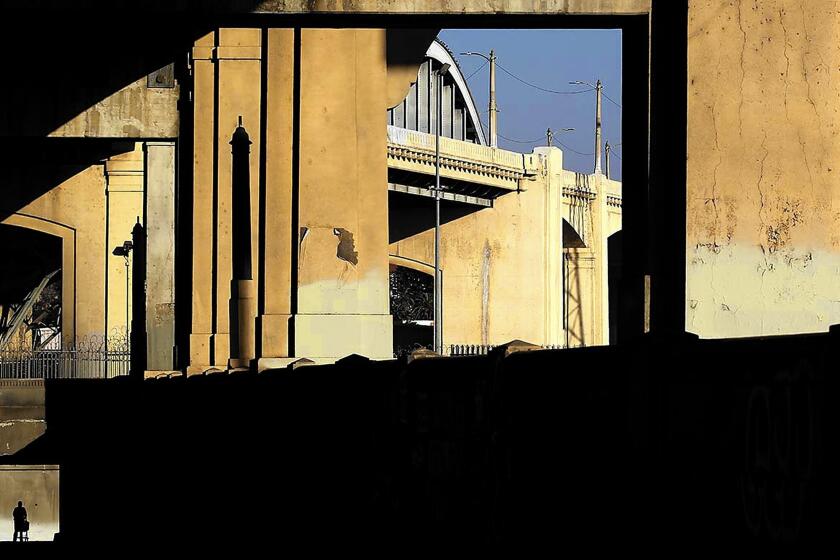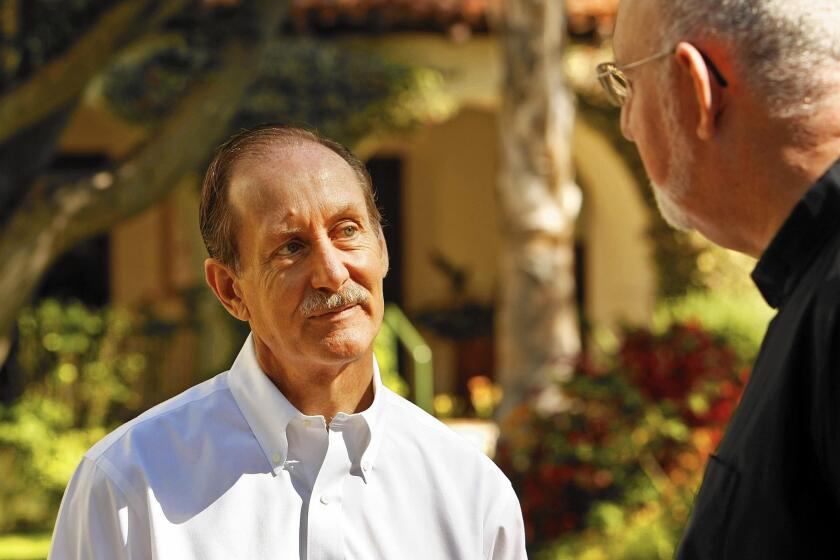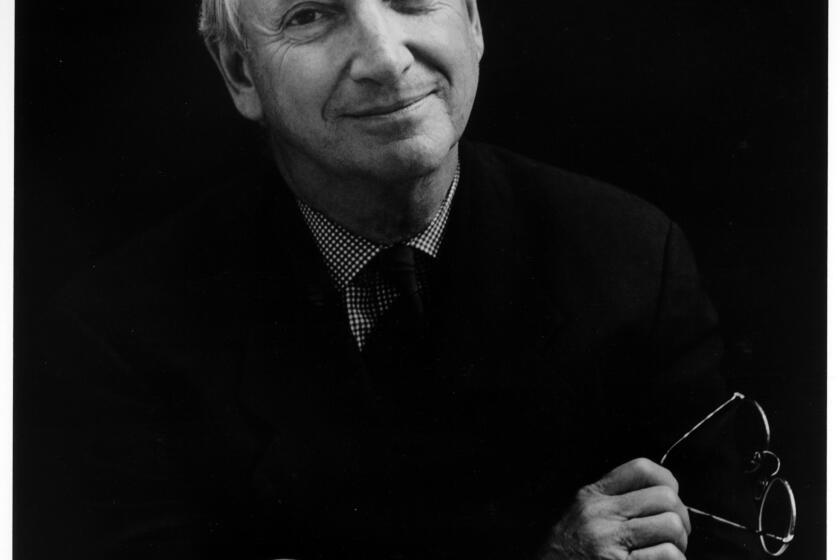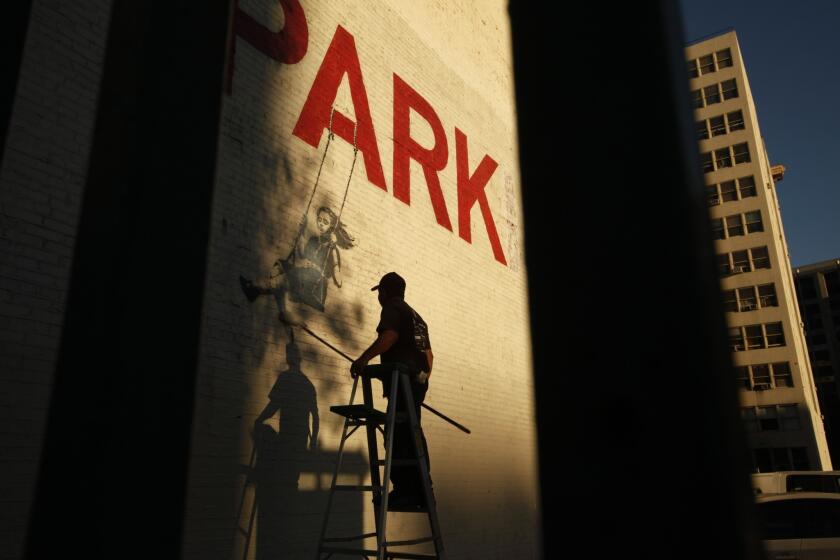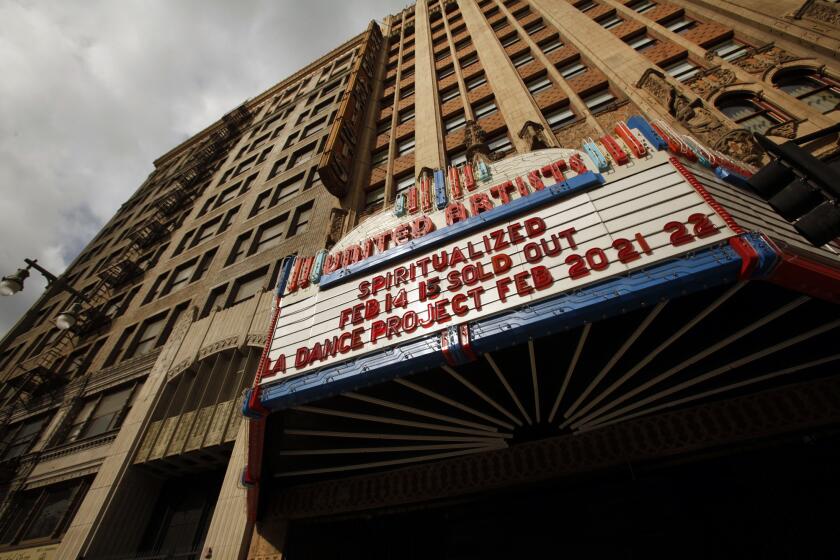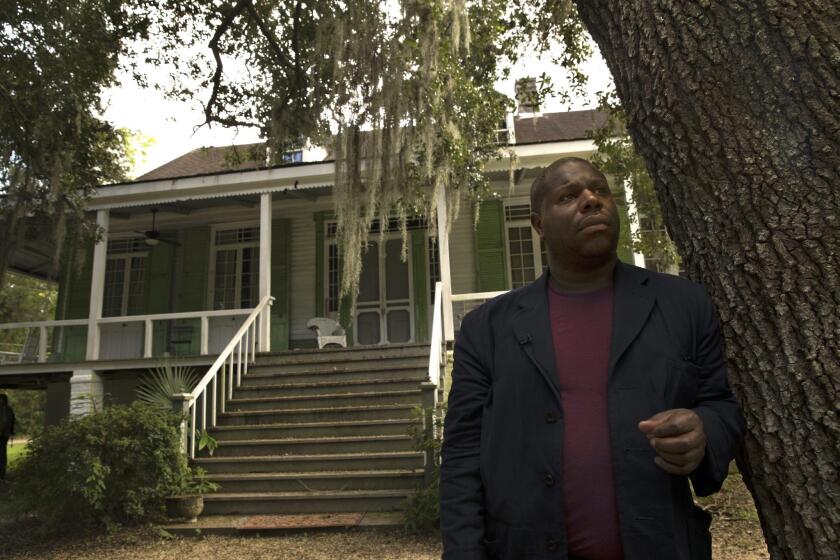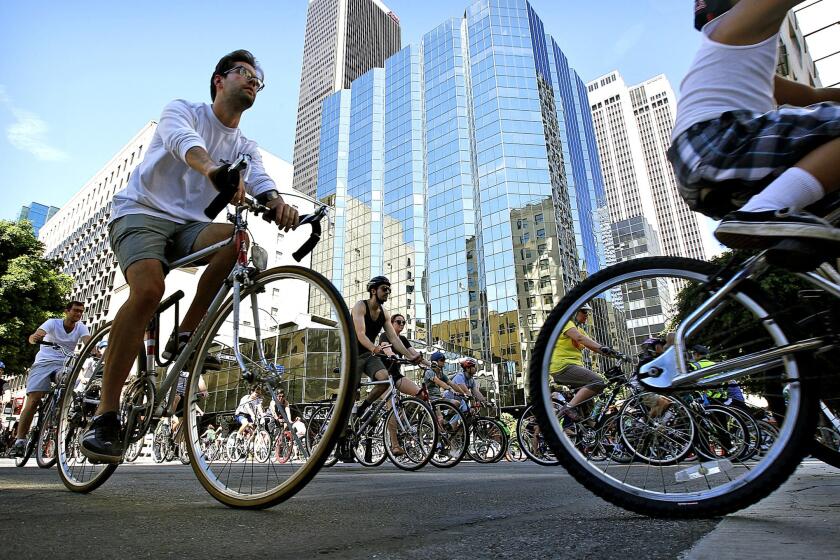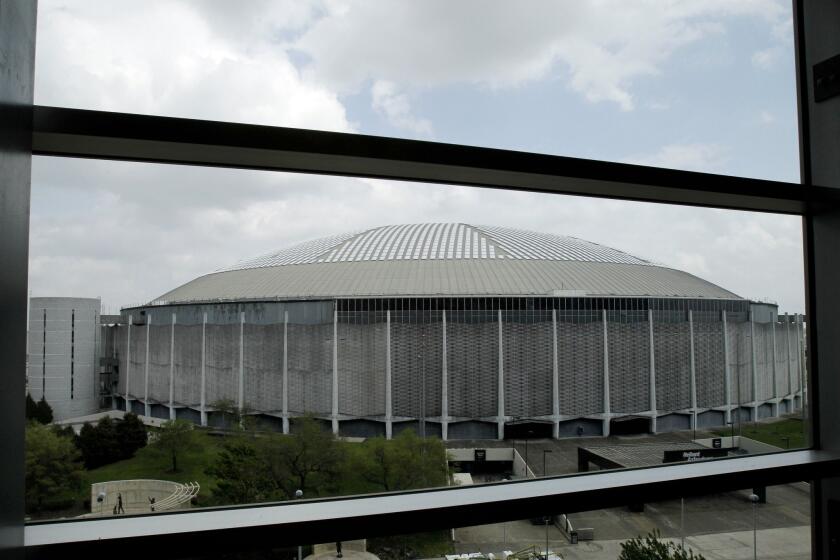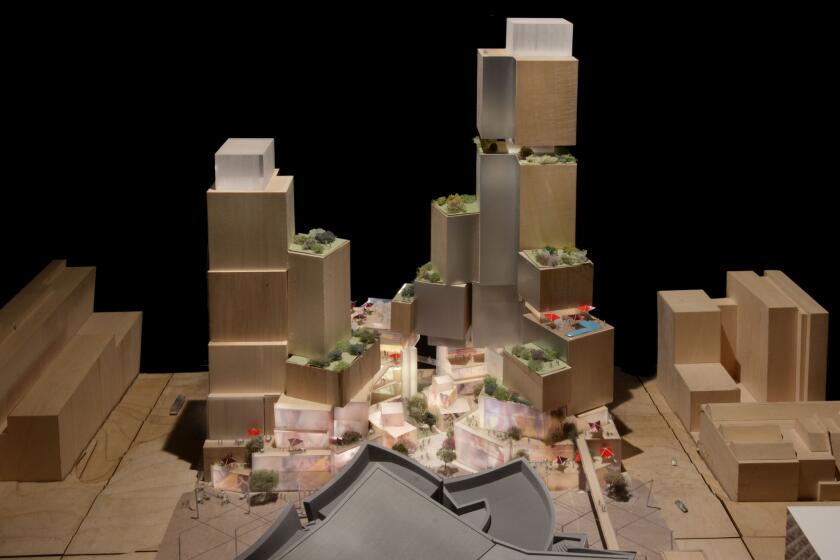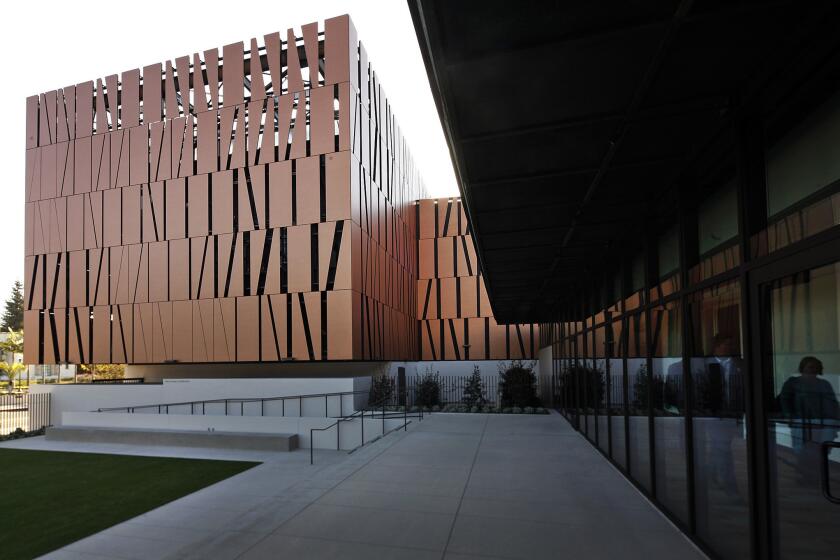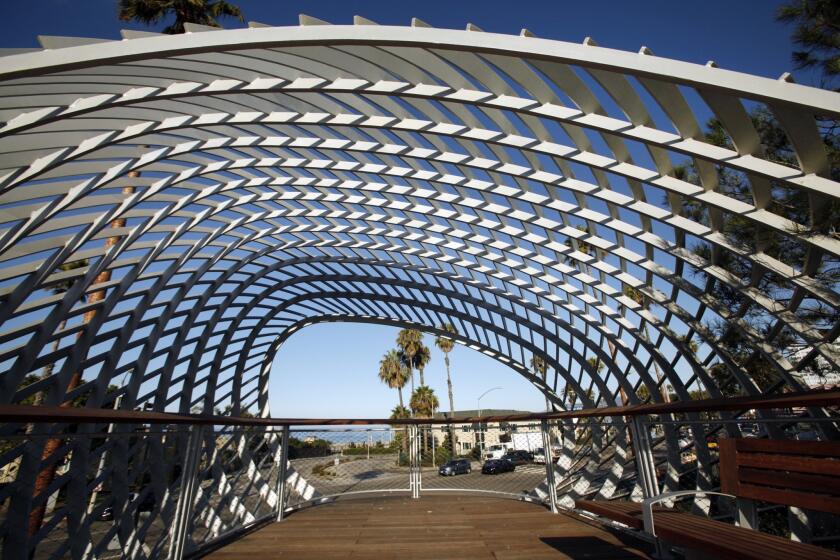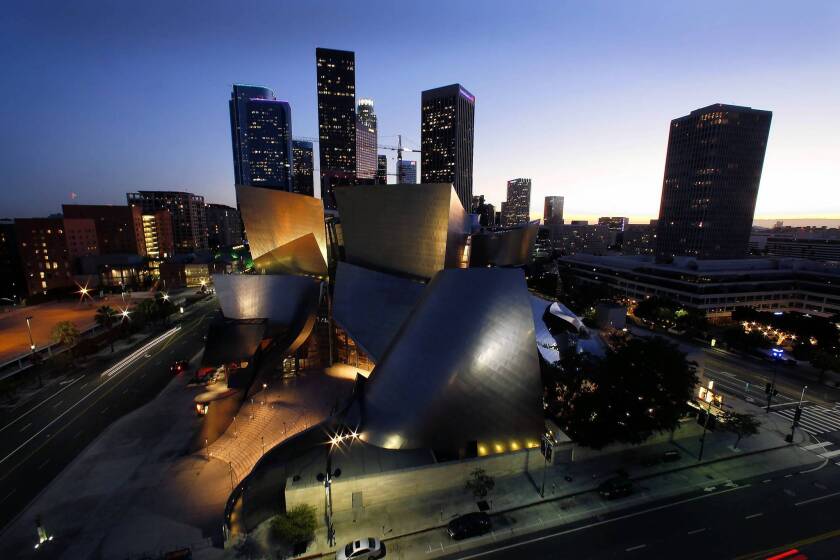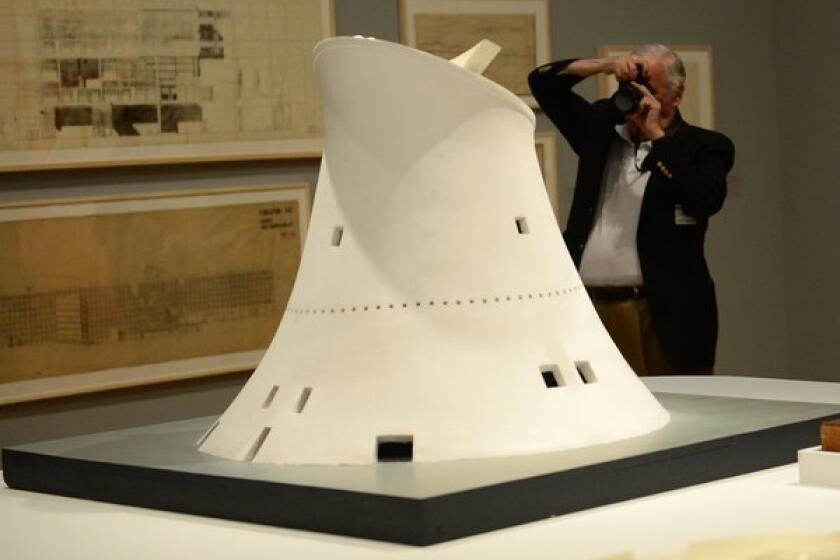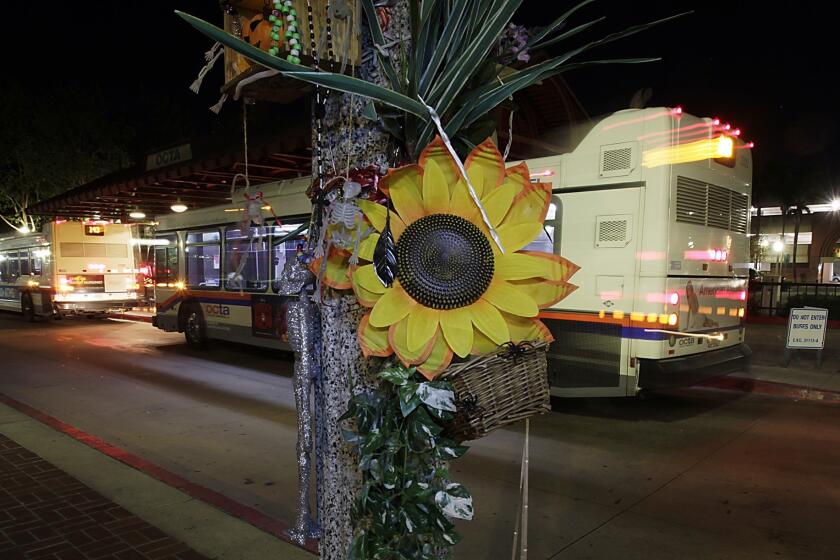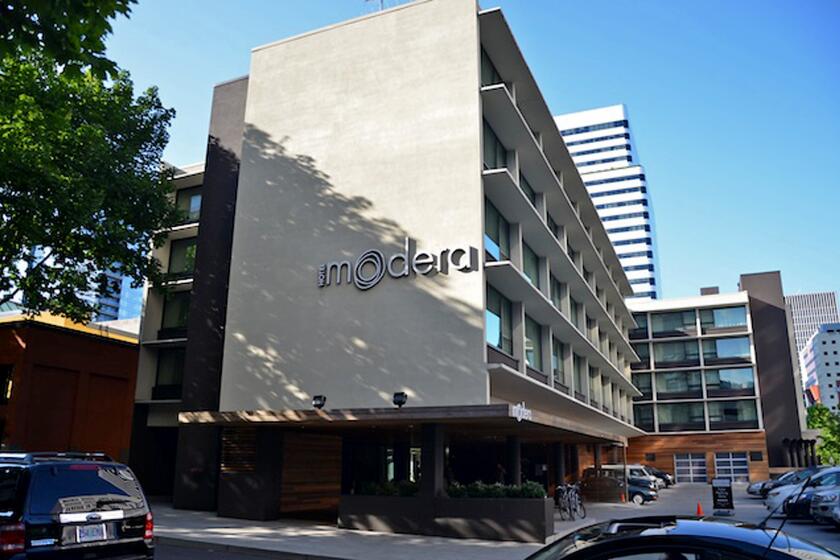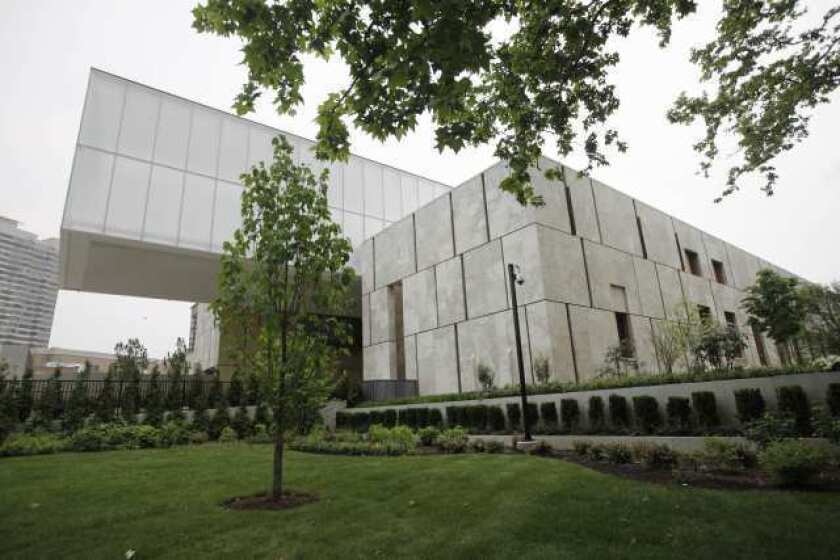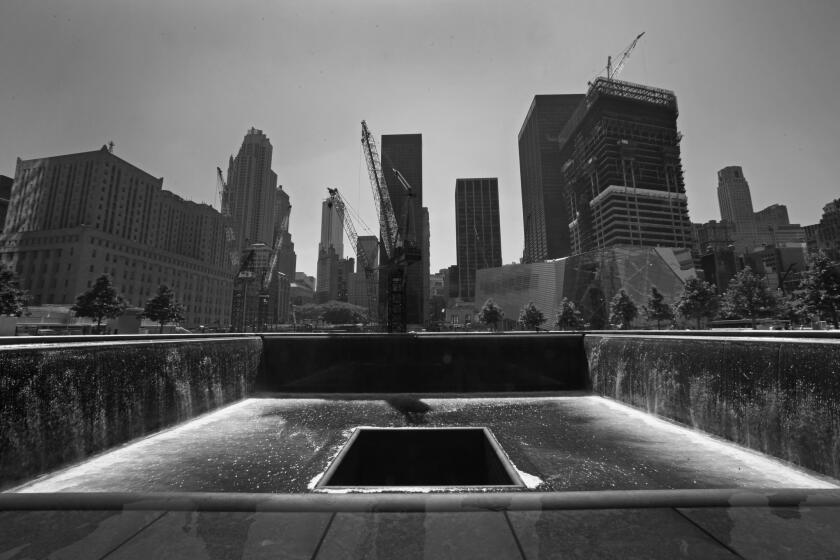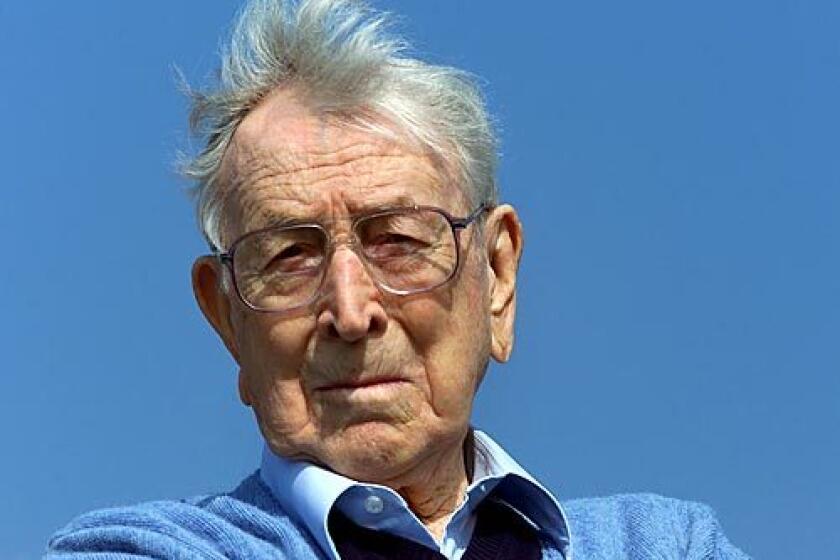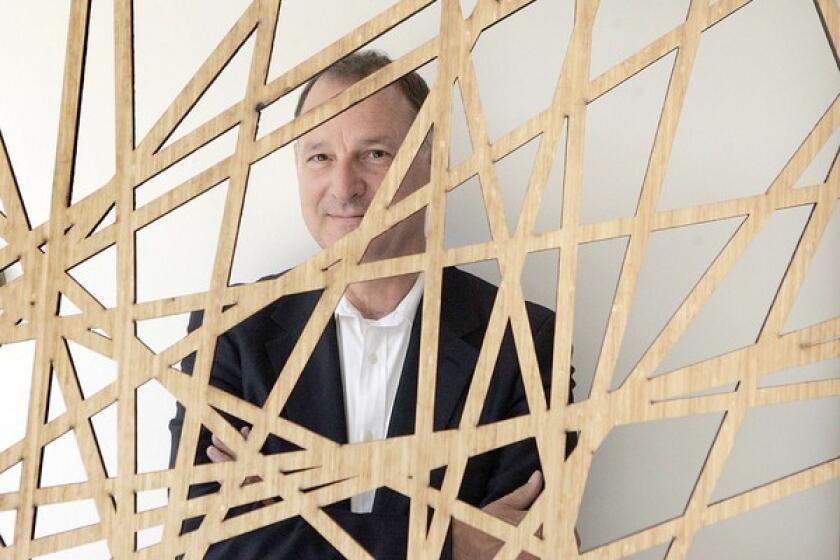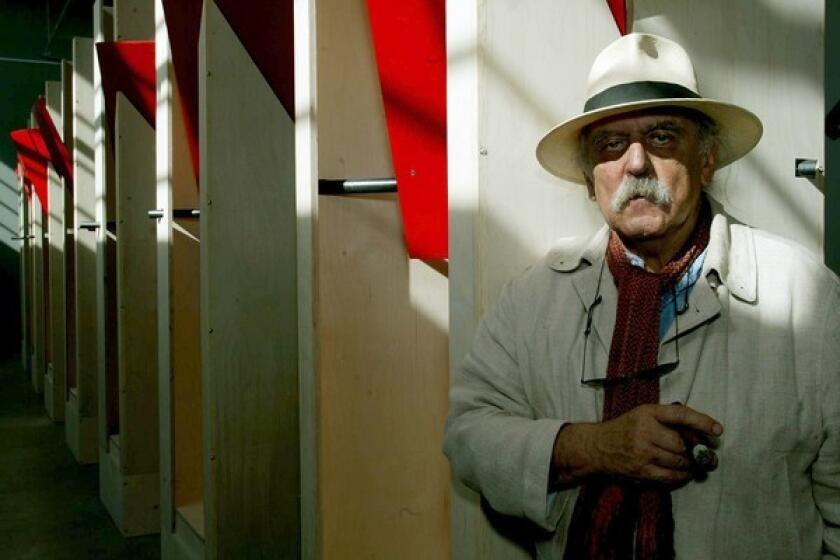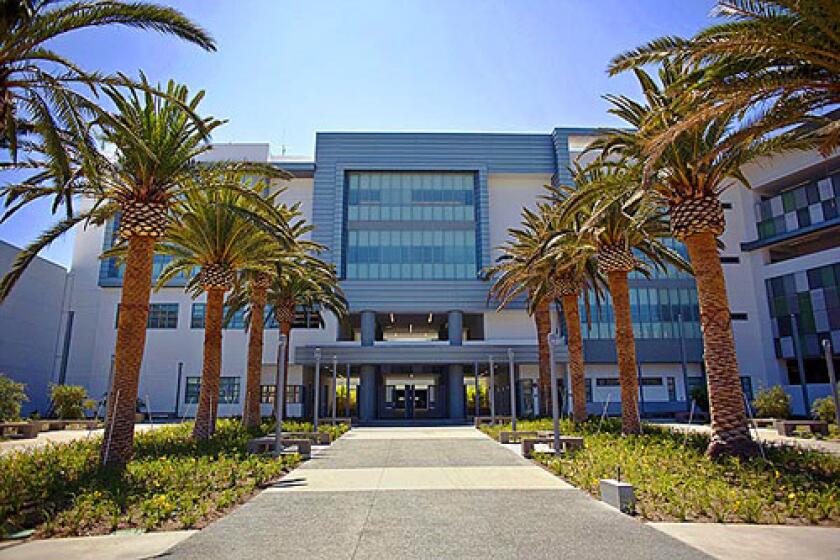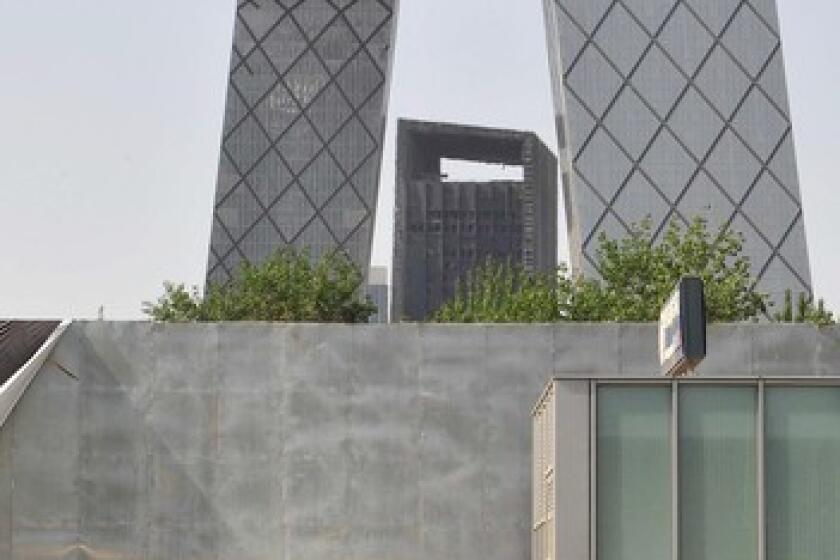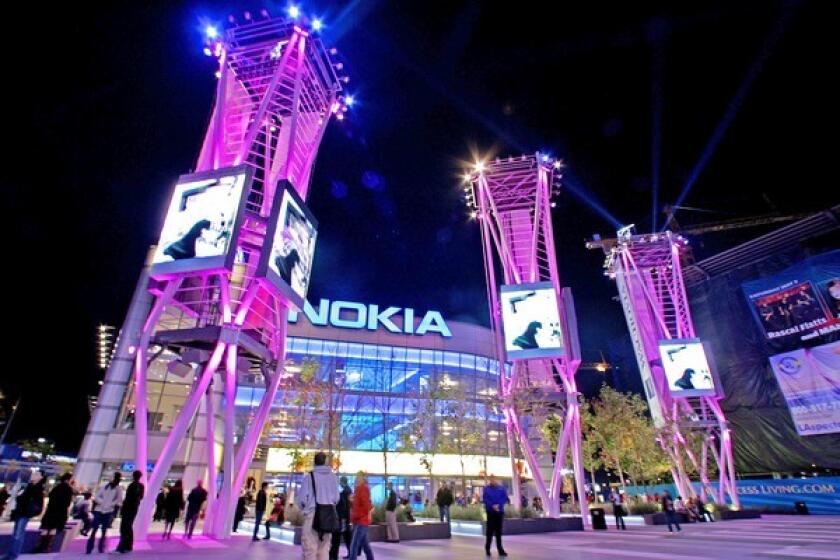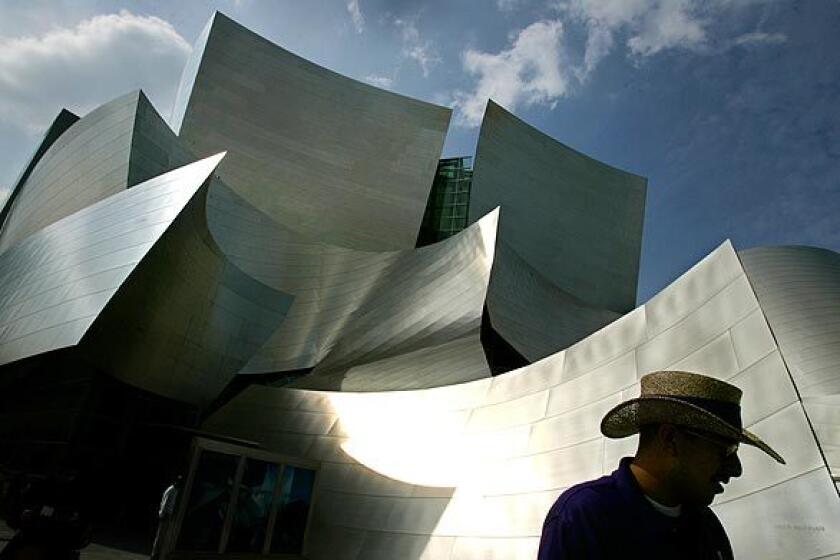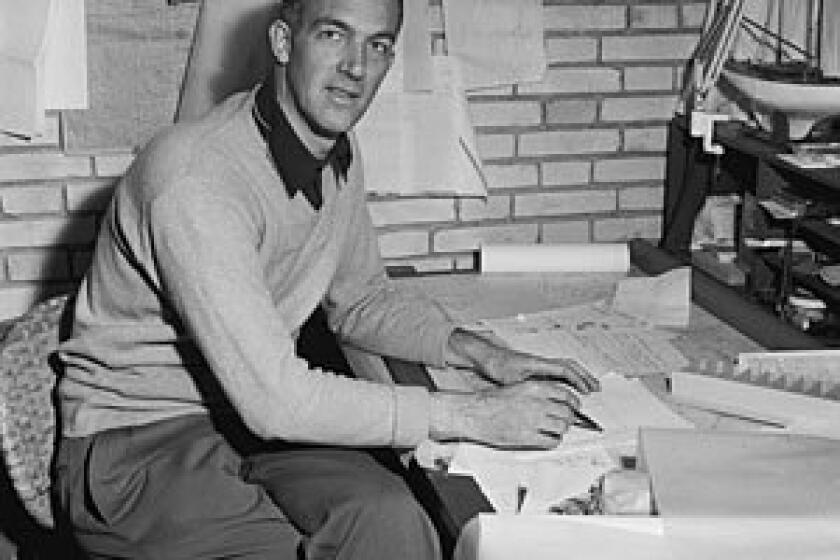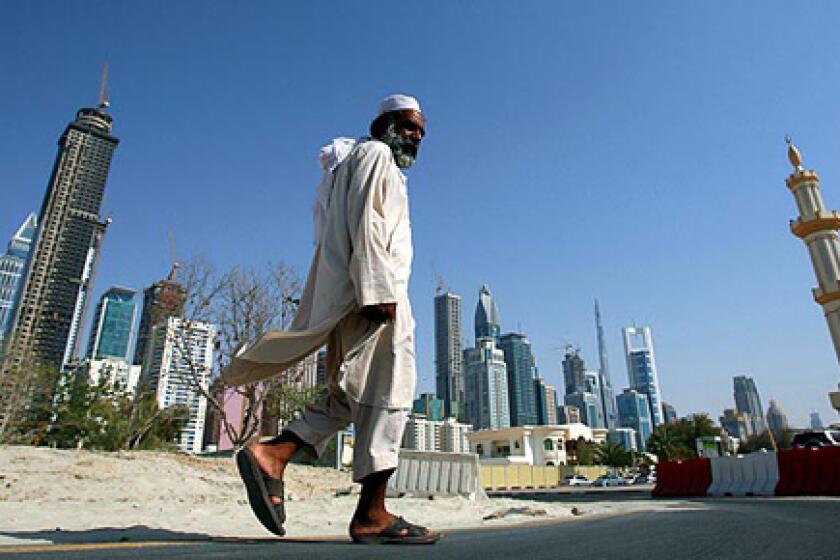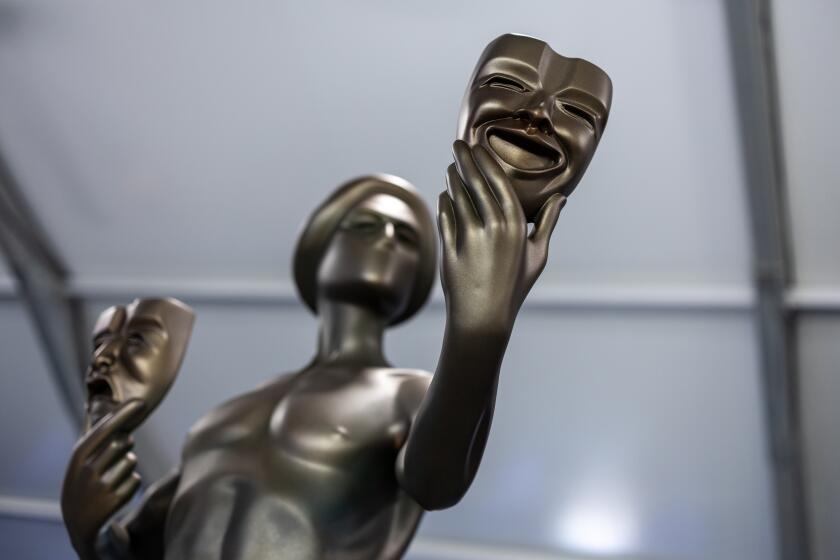Christopher Hawthorne, Architecture Critic
- 1
Frank Gehry agreed to make over the L.A. River -- with one big condition
- 2
The 3-year-old house owned by Jeanne and Anthony Pritzker, high on Angelo Drive in the upper reaches of Beverly Hills, is a vast and imposing neo-modern chateau, loosely Richard Meieresque in feel, that holds a notable collection of contemporary art and covers 49,000 square feet.
- 3
Work crews in recent weeks have made major design changes to Broadway in downtown Los Angeles, widening the sidewalks and adding planters, chairs and round cafe tables with bright-red umbrellas where rows of parked cars used to be.
- 4
Not many architects can claim to have spearheaded a major design movement.
- 5
Most Los Angeles architects are lucky if they complete two or three houses by their early 30s.
- 6
Critic’s Notebook: The Broad museum’s opening date is delayed to 2015, but more interesting is who will run its planned plaza and how.
- 7
Critic’s Notebook: Small design tweaks from the Piano-Pali team can’t overcome the disconnection that radiates from the clumsy domed exterior of the academy’s planned film museum.
- 8
Thom Mayne and Morphosis make the most of a blank slate on Sunset with the striking and self-contained Emerson building.
- 9
Austrian Hans Hollein, Pritzker Prize winner who ushered in architecture’s post-modernism movement in the 1970s, has died at 80.
- 10
A new template for future subway and light-rail routes finds Metro moving toward a much-needed consistency, if colorlessly so.
- 11
Critic’s Notebook: The architecture of downtown L.A.’s United Artists Theatre, now part of the Ace Hotel, and the Forum was preserved when they were owned by two religious groups. They have new owners and new life as concert venues.
- 12
Critic’s Notebook: Spike Jonze boldly bucks the retro trend in creating a vivid future L.A. in ‘Her,’ a thoughtful meditation on tech and culture.
- 13
Notes on the Year: This year Los Angeles entered fresh civic territory as a range of initiatives across the city helped fuel an urban reawakening.
- 14
Times architecture critic Christopher Hawthorne picks the year’s top developments, including 4 World Trade Center and L.A.’s cornfield plan.
- 15
Critic’s Notebook: In ’12 Years a Slave’ and his other works, artist and filmmaker Steve McQueen rethinks the relationship between the built environment and the camera.
- 16
‘Deborah Sussman Loves Los Angeles’ at Woodbury University’s WUHO Gallery in Hollywood explores the designer’s early career, including her bold, collaborative graphic work for the 1984 Olympics.
- 17
The soaring elegance of architect Fumihiko Maki’s design at ground zero may help rehabilitate the strong-arm tactics of developer Larry Silverstein.
- 18
Critic’s Notebook: CicLAvia, which on April 6 will empty a stretch of Wilshire of car traffic for cyclists and pedestrians, is a chance to rethink L.A.’s future and skewed car-first perspective.
- 19
Critic’s Notebook: Houston is deciding whether to invest in Astrodome’s future. If Proposition 2 fails, the stadium could be razed soon. The venue should be preserved.
- 20
Critic’s Notebook: The Getty-led Pacific Standard Time Presents series was intriguing in parts, but it lacked a clear central vision.
- 21
Architect Frank Gehry’s design for a Grand Avenue retail, hotel and residential complex across from Walt Disney Concert Hall will be submitted Monday.
- 22
The new Wallis Annenberg Center for the Performing Arts artfully blends old architecture with new, with parking of course.
- 23
Swiss architect Peter Zumthor’s works show great detail and firm connection to European landscape. Can he translate to Los Angeles County Museum of Art?
- 24
The ‘Windshield Perspective’ Pacific Standard Time Presents exhibition at the Architecture and Design Museum gets a little lost on Beverly Boulevard.
- 25
The messy run-up to the Geffen Contemporary’s exhibition culminates in a jumble of work that marks how closed off the profession in Southern California has become.
- 26
Critic’s Notebook: The muscular work of late-modern architecture, which has suffered a loss at the ballot box, makes a test case for the health of the preservationist movement.
- 27
Critic’s Notebook: Turmoil over development plans for downtown L.A.’s Grand Avenue leaves many questions unanswered but opens up the possibility of moving in a new direction.
- 28
Critic’s Notebook: Amid the proliferation of prisons, debate over their future has exposed the facilities, and details of their architecture, to new scrutiny.
- 29
A nonprofit dedicated to the L.A. River announces plans for a 51-mile greenway. But it’s a decision from Washington that everyone is waiting for.
- 30
Critic’s Notebook: Dealey Plaza, the site of JFK’s assassination, is a curious hybrid of intersection and accidental monument, an unlovely, architecturally unresolved prick on the Texas city’s conscience.
- 31
Critic’s Notebook: The Rancho Mirage estate, set to host President Obama and Chinese leaders, has deftly embraced its mission of public interaction.
- 32
Architect Moshe Safdie, who designed the cultural center’s original buildings and its new additions, is featured in the upcoming ‘Global Citizen.’
- 33
Paolo Soleri, a former apprentice of Frank Lloyd Wright, brought his vision of ecologically sensitive urban living to the Arizona desert four decades ago. Arcosanti never exactly flourished, but Soleri’s emphasis on denser, vertical settlements is echoed in today’s green architecture.
- 34
In Santa Monica, landscape architect James Corner of High Line fame creates an urban refuge that plays it a bit too safe.
- 35
Frank Gehry’s Disney Hall, a remarkable work of public architecture, reflects and engages Los Angeles like few other buildings.
- 36
Director Michael Govan turns to Swiss architect Peter Zumthor for a dramatic new building that would involve demolishing the main museum campus.
- 37
It’s time to get reacquainted with LACMA’s ‘old’ buildings before their future is decided
- 38
Critic’s Notebook: A MoMA show’s thesis that the architectural giant put concern with the natural world at the center of his work defies conventional wisdom.
- 39
Though Orange County’s Harbor Boulevard remains little changed, a history of unrest points to its potential to more positively engage with street life beyond the auto.
- 40
Ada Louise Huxtable’s fiery criticism helped shape New York City in the 1960s and ‘70s. The Pulitzer Prize winner addressed not just the aesthetics but the politics of architecture.
- 41
- 42
A gigantic glass dome would dominate the proposed $300-million facility by architects Renzo Piano and Zoltan Pali attached to the May Co. building on Wilshire Boulevard.
- 43
The quick look at architectural landmarks in U.S. history, including the Virginia State Capitol and Walt Disney Concert Hall, is a good conversation-starter.
- 44
The agency is facing an identity crisis over its relationship to architecture and urban design.
- 45
PHILADELPHIA — Philadelphia, the city that gave us Poor Richard, cheese-steak sandwiches and the American Constitution, just opened a new treasure: the Barnes Foundation, one of the premier privately assembled collections of painting in the U.S. with more dreamy Renoirs and searching Cézannes than in the whole of France.
- 46
Pacific Pie Co., Oblation print shop and the Pearl District are part of the town’s charms. Hotel Modera has original art and an upscale restaurant, Nel Centro.
- 47
The major architecture exhibition faces cancellation now that its central focus is no longer part of the show.
- 48
One of the most controversial moves in recent art-world memory, the relocation of the Barnes Foundation, has drawn the national press to Philadelphia where the venerated art institution opened its new building earlier this month.
- 49
Ricardo Legorreta incorporated elements of Mexican vernacular architecture into modern design and found a global audience. He redesigned Los Angeles’ Pershing Square in 1993.
- 50
There are many books of the architectural photographer’s work; a co-author of the newest one explains what it adds.
- 51
The design competition for the new U.S. embassy in London has opened a broader discussion into how America sees itself.
- 52
The design by Michael Arad and Peter Walker has weathered a long process of changes intact enough to be effective.
- 53
Is the gavel and block the right way to sell a significant home? The sluggish housing market is having an impact. And what about preservation? Buyer interest might come too late.
- 54
Amid the backdrop of the creation of two connected parks near City Hall by the ascendant Field Operations is a fascinating interplay of urban design and public engagement.
- 55
Chase championed civic space and vernacular architecture in Southern California. He was perhaps best known for his writing on architecture, urbanism, planning and preservation.
- 56
To him, architecture has a role in resolving the complexities of culture, not necessarily dramatizing them.
- 57
The prolific Lumsden helped develop new ways of wrapping buildings in smooth glass skins, accelerating a shift that reshaped skylines around the world.
- 58
It’s understandable why director Christopher Nolan would lean so heavily toward familiar architectural forms, but too bad such a mind-bending narrative lacks equally inventive structures.
- 59
Aqua, the undulating, 82-story structure, brings a fresh approach to skyscraper design.
- 60
New York developers are reviving plans to surround the Capitol Records building with a mixed-use project covering 1 million square feet. Whether it would enhance or detract from the iconic structure depends on fuzzy details.
- 61
Abraham, whose Austrian Cultural Forum building in New York is among the most forceful architectural pieces of the last decade, had taught at the Southern California Institute of Architecture.
- 62
Skyscrapers, viewed in many parts as signs of prestige, have experienced a building boom since the attacks.
- 63
The billionaire is reportedly looking at a Grand Avenue site for his art museum. Here’s what city officials should have in mind for possible negotiations.
- 64
Car culture and the benefactor’s public versus private lives are woven into the design that was submitted into competition.
- 65
LAUSD’s bold new campus for Central Los Angeles Area High School #9 flaunts a district’s-worth of design at one site. Given the architect and client, conflict, rethinking and missteps were inevitable.
- 66
Though the overall design meshes well as a public campus, the district’s push to re-create the look of the old hotel winds up feeling like an empty gesture to history.
- 67
“(500) Days of Summer” is a movie about obsessions -- gentle, often charming and non-stalkerish obsessions, for the most part, but obsessions all the same.
- 68
Real power remained elusive for even them.
- 69
The architect, now 80, is uncharacteristically candid on some fronts, but the wall stands firm in others.
- 70
Critic’s Notebook: Why the hotel is worth saving from a plan to replace it with a $2-billion, mixed-use project.
- 71
Thomas S. Hines fleshes out the heroes of L.A. architecture with a smart look at their most important buildings.
- 72
With funding now in sight, a new book reminds us of the unseen physical pieces and a designer’s role.
- 73
When all the walls talk, what does it mean for architecture?
- 74
From bungalow to midcentury modern, a quest for perfect living.
- 75
A waste-free, green-tech city on the sands of the Arabian peninsula? A Gehry Guggenheim and mini-Louvre to anchor a $27-billion cultural center? It’s a paradoxically forward-thinking vision.
- 76
The vote on transportation funding has implications for how we build, perceive and experience L.A.
- 77
As the renowned architect turns 80, the recession slows down his remaining grand projects.
- 78
The star system doesn’t cast much light, but some national pavilions shine.
- 79
Jorn Utzon, the Danish architect whose eye-catching, nautically inspired design for the Sydney Opera House overcame a series of controversies surrounding its budget and acoustics to become one of the most recognizable landmarks of the 20th century, helping to usher in the current era of buildings beloved for their daring and photogenic forms, has died.
- 80
Modernism wiped out many historic buildings. Now the newer landmarks are targeted by wrecking balls. Oddly, the green movement could come to the rescue.
- 81
Art and nature coexist in Renzo Piano’s creation.
- 82
Renzo Zecchetto’s Eli and Edythe Broad Stage at Santa Monica College appears unresolved. And that’s fine.
- 83
Many of the city-state’s bigger-than-life projects may be in a holding pattern, but don’t look for its mega-growth world influence to be contained any time soon.
- 84
Quality control is another matter, though.
- 85
‘What I’ve learned . . . is that if there’s one reaction to architecture that I know I can trust, and that won’t waver on later visits, it’s a visceral rather than an intellectual one.’
- 86
Architecture worldwide becomes subject to ‘buildering.’
- 87
‘Between Earth and Heaven: The Architecture of John Lautner’ seeks to save the ‘Chemosphere’ architect from stereotypes.
- 88
Beaux-Arts house is now historic in spirit yet contemporary in sinew.
- 89
Both visions for downtown’s civic plaza are less than inspiring and raise questions about how the design will be handled.
- 90
The Athenian stadium backdrop for the Democratic candidate’s acceptance speech is rife with symbolism.
- 91
An excerpt from a new book chronicles the cutting-edge architects who are bringing high style to once-frumpy eco-friendly homes.
- 92
The $30-million renovation reaffirms -- and complicates -- its landmark stature.
- 93
Opportunities abound for foreign architects, as well as moral and environmental issues.
- 94
Buildings are designed with pollution in mind. White is definitely out.
